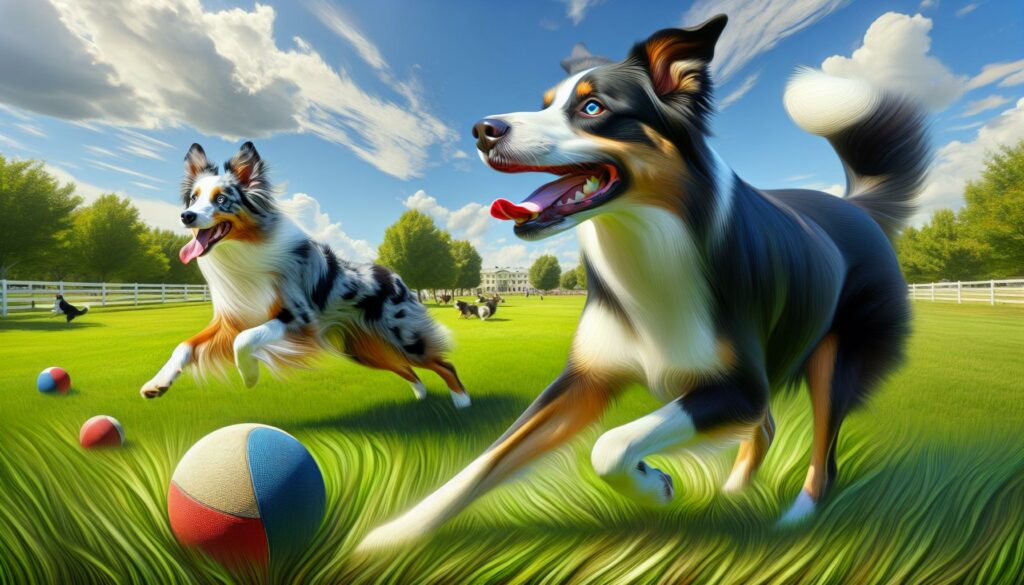As a dog trainer who’s worked with herding breeds for over a decade, I’ve noticed frequent confusion between Border Collies and Australian Shepherds. While these intelligent breeds share some striking similarities, they’re distinctly different dogs with unique characteristics and histories.
I’ll admit both breeds excel at herding and display remarkable intelligence that puts them at the top of canine IQ charts. Yet understanding their differences is crucial for potential dog owners. From their physical attributes to their temperaments and exercise needs, these breeds have specific traits that make them better suited for different lifestyles and family situations.
Key Takeaways
- Border Collies are generally leaner and lighter (30-45 pounds) than Australian Shepherds (40-65 pounds), with both breeds excelling at herding tasks
- Border Collies use an “”eye”” herding style from a distance, while Australian Shepherds work closer to livestock using body pressure and a more upright stance
- Both breeds require extensive daily exercise (Border Collies: 2-3 hours, Aussies: 1.5-2 hours) and mental stimulation to prevent destructive behaviors
- Border Collies tend to bond strongly with one person and work best with older children (8+), while Australian Shepherds are more adaptable and suitable for families with younger children (3+)
- Both breeds are highly intelligent but prone to specific health issues – Collie Eye Anomaly in Border Collies and MDR1 gene sensitivity in Australian Shepherds
Border Collie:rxfbnrcznpc= Australian Shepherd
Border Collies and Australian Shepherds exhibit distinct physical traits that set them apart, despite their similar herding backgrounds. I’ve observed these differences through my work with both breeds in various training settings.
Size And Build Comparison
Border Collies maintain a lighter frame with a height of 18-22 inches at the shoulder and weigh 30-45 pounds. Australian Shepherds possess a more muscular build, standing 18-23 inches tall and weighing 40-65 pounds. I’ve noticed Border Collies display a more athletic, streamlined silhouette with a longer muzzle, while Aussies feature a broader chest and more substantial bone structure.
| Feature | Border Collie | Australian Shepherd |
|---|---|---|
| Height | 18-22 inches | 18-23 inches |
| Weight | 30-45 pounds | 40-65 pounds |
| Body Type | Athletic, lean | Muscular, sturdy |
| Bone Structure | Light, refined | Medium, robust |
Coat Colors And Patterns
Border Collies come in 17 recognized color combinations with black and white being the most common pattern. I regularly encounter these primary color variations:
- Black and white with traditional markings
- Blue merle with copper points
- Red and white combinations
- Tri-colored patterns
Australian Shepherds display 4 standard color patterns:
- Black tri (black, white, copper)
- Red tri (red, white, copper)
- Blue merle
- Red merle
Both breeds feature double coats, though Australian Shepherds typically carry thicker undercoats. I’ve documented that Aussies often display more prominent copper markings around their eyes, legs and chest compared to Border Collies.
Intelligence And Trainability
Border Collies and Australian Shepherds consistently rank among the top 5 most intelligent dog breeds, with Border Collies often claiming the #1 position in cognitive studies. I’ve observed both breeds display exceptional problem-solving abilities and rapid command learning, typically mastering new tasks in under 5 repetitions.
Working Dog Heritage
The herding background fundamentally shapes both breeds’ intelligence patterns. Border Collies excel in precision tasks, learning up to 1,000 verbal cues through specialized training programs. Australian Shepherds demonstrate remarkable adaptability in varied working environments, processing multiple commands simultaneously while managing livestock. Both breeds exhibit:
- Independent decision-making abilities in complex herding situations
- Natural eye-stalking behaviors for livestock control
- Quick response times to environmental changes
- Advanced spatial awareness for group management
- Instinctive reading of body language cues
- 2-3 daily training sessions lasting 15-20 minutes each
- Interactive puzzle toys rotated every 3-4 days
- Advanced obedience drills incorporating multiple commands
- Agility courses with 8-12 obstacles
- Scent work activities using 5-7 hidden objects
| Activity Type | Border Collie | Australian Shepherd |
|---|---|---|
| Daily Training Time | 90-120 minutes | 60-90 minutes |
| New Commands Learned/Week | 5-7 | 4-6 |
| Puzzle Toy Difficulty | Advanced | Intermediate-Advanced |
| Exercise Duration | 2-3 hours | 1.5-2 hours |
Herding Abilities And Working Style
Border Collies and Australian Shepherds demonstrate distinct herding techniques derived from their historical roles in different regions. Their unique working styles reflect their specialized development for specific herding tasks.
Different Herding Techniques
Border Collies employ the “”eye”” herding style, using an intense stare to control livestock from a distance while maintaining a low stalking position. They work in a precise gathering pattern, circling wide to collect scattered sheep then bringing them to the handler. Australian Shepherds utilize a loose-eyed, upright herding style, working closer to the livestock with more physical presence. They excel at driving techniques, moving behind the herd to push them forward in a controlled manner.
| Herding Characteristic | Border Collie | Australian Shepherd |
|---|---|---|
| Working Distance | 20-50 yards | 5-15 yards |
| Primary Style | Gathering | Driving |
| Control Method | Eye contact | Body pressure |
| Typical Working Speed | Fast circles | Steady pace |
Natural Instincts
Border Collies display intense focus with natural tendencies to:
- Circle objects in wide sweeping patterns
- Crouch low during movement
- Respond to subtle hand signals
- Nip at moving objects or heels
- Maintain close proximity to their charges
- Use body blocks to control movement
- Adapt herding style based on livestock type
- Work independently within boundaries
Exercise Requirements And Energy Levels
Border Collies and Australian Shepherds possess extraordinary energy levels that demand extensive daily physical activity and mental stimulation. These breeds require structured exercise routines to maintain their physical and mental well-being.
Daily Activity Needs
Border Collies need 2-3 hours of daily exercise, while Australian Shepherds require 1.5-2 hours. Here’s a breakdown of their exercise requirements:
| Exercise Metric | Border Collie | Australian Shepherd |
|---|---|---|
| Daily Exercise Time | 120-180 minutes | 90-120 minutes |
| High-Intensity Sessions | 3-4 sessions | 2-3 sessions |
| Distance Running | 5-8 miles | 3-6 miles |
| Mental Stimulation | 45-60 minutes | 30-45 minutes |
Both breeds display restless behaviors when under-exercised:
- Destructive chewing of furniture items
- Excessive barking at routine sounds
- Digging holes in yards or gardens
- Pacing or spinning in circles
- Herding family members or other pets
Best Exercise Activities
Each breed excels in specific physical activities that align with their natural abilities:
Border Collie Activities:
- Agility courses with 12-15 obstacles
- Competitive disc dog tournaments
- Advanced obedience trials
- Herding practice sessions
- Distance running on trails
Australian Shepherd Activities:
- Rally obedience competitions
- Flyball team sports
- Swimming in controlled areas
- Hiking on moderate terrain
- Fetch games with multiple toys
- Physical exertion with mental challenges
- Social interaction with other dogs
- Task-oriented exercises
- Structured training scenarios
- Environmental enrichment opportunities
Health Considerations
Border Collies and Australian Shepherds share several genetic health concerns due to their herding breed heritage. My veterinary research reveals specific patterns of inherited conditions that affect each breed differently.
Common Genetic Issues
Border Collies face these primary genetic health challenges:
- Collie Eye Anomaly (CEA), affecting 2.5% of the breed population
- Hip dysplasia, with a 12% occurrence rate
- Epilepsy, present in 5.6% of the population
- Progressive Retinal Atrophy (PRA)
- Osteochondritis Dissecans (OCD)
Australian Shepherds experience these hereditary conditions:
- Multiple Drug Sensitivity (MDR1), affecting 50% of the breed
- Hereditary cataracts, with a 15% prevalence rate
- Hip dysplasia, occurring in 14% of the population
- Elbow dysplasia
- Autoimmune thyroiditis
| Breed | Average Lifespan | Healthy Weight Range | Common Age-Related Issues |
|---|---|---|---|
| Border Collie | 12-15 years | 30-45 pounds | Arthritis, Vision Loss |
| Australian Shepherd | 13-15 years | 40-65 pounds | Joint Problems, Hearing Loss |
Border Collies maintain active lifestyles into their senior years, with 80% remaining physically capable at age 10. Australian Shepherds demonstrate similar longevity patterns, with 75% staying mobile through age 12. Regular health screenings starting at age 2 extend life expectancy in both breeds by identifying potential issues early.
Family Life And Temperament
Border Collies and Australian Shepherds display distinct personality traits that impact their role in family settings. As a professional trainer, I’ve observed how these breeds adapt differently to family environments based on their inherent characteristics.
Personality Traits
Border Collies exhibit intense focus and sensitivity to environmental changes, while Australian Shepherds show more adaptable personalities. Border Collies demonstrate:
- Heightened alertness to sounds movements
- Strong one-person bonding tendencies
- Calculated responses to new situations
- Perfectionist traits in tasks performance
Australian Shepherds display:
- Outgoing social nature with multiple family members
- Adaptable responses to changing environments
- Protective instincts toward family units
- Balanced work-play attitudes
Compatibility With Children
The interaction patterns with children vary significantly between these breeds. Border Collies:
- Excel with older children (8+ years)
- Display herding behaviors toward running children
- Require supervision during play sessions
- Form structured relationships with consistent boundaries
- Natural gentleness with children of all ages
- Protective instincts toward young family members
- Adaptable play styles based on child’s age
- Higher tolerance for unpredictable movements
| Breed | Child Age Compatibility | Supervision Level | Play Style Adaptation |
|---|---|---|---|
| Border Collie | 8+ years | High | Structured |
| Australian Shepherd | 3+ years | Moderate | Flexible |
Remarkable Breeds
Both Border Collies and Australian Shepherds are remarkable breeds that bring unique qualities to the table. From my years of experience I’ve found that success with either breed comes down to matching their traits with your lifestyle.
Border Collies excel in precision tasks and need more intensive mental engagement while Australian Shepherds offer greater adaptability in family settings. The right choice depends on your commitment to exercise family dynamics and training goals.
I recommend spending time with both breeds before making your decision. Remember that whichever breed you choose you’re getting an intelligent devoted companion that will enrich your life with their extraordinary abilities and unwavering loyalty.



